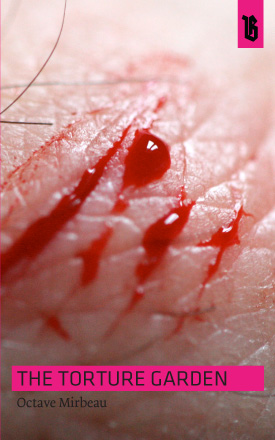 This story sails under false colours.
This story sails under false colours.
During the golden age of piracy it was common for pirates to deceive merchant vessels by flying the flag of a friendly country, such as the Union Flag or the Cross of Burgundy. Only when escape was impossible would they run up the Jolly Roger. This book used a similar trick on me. It starts out as a funny story where a caddish young politician, drowning in bad publicity, flees the country on a boat bound for the far East. Soon (while he’s at sea, incidentally) The Torture Garden completely changes in tone and style.
Octave Mirbeau was a 19th century French journalist, novelist, and full-time burr in the establishment’s saddle. This is one of his most remembered works: a very excessive satire story that seems to be the bang-from-behind offspring of Jonathan Swift and the Marquis de Sade. The hero (nameless, as best I can recall) meets shipboard a depraved young woman called Clara, who has all sorts of issues to discuss with her inner child. She seems demur and immune to flattery, but comes to life at the slightest hint of cruelty, violence, or pain.
The book is very funny. The characters are picaresque and exaggerated like the ones in George MacDonald Fraser’s Flashman books. I laughed at several parts, such as this exchange, where a sailor is attempting to impress Clara.
“Well then?” she said maliciously, “so it’s not a joke? You’ve eaten human flesh?”
“Certainly I have!” he answered proudly with a tone that established his indisputable superiority over the rest of us.
Clara and her male companion journey to China’s famous “Torture Garden”, a place where criminals go to die. The Asians are sophisticated and evolved in this matter. Where Europe allows its prisoners to languish in dark dungeons, China’s prisoners live and die in massive gardens well equipped for all forms of torture. Viburnums enriched by bilirubin. Azaleas watered by arterial gore.
Mirbeau writes satire really well. One of the funniest parts has a seasoned Chinese torture ranting about Westerners invading the land and bringing their crude and barbaric methods of torture with them, with no respect for Chinese tradition.
Our protagonist’s goes on a tour through this garden, learning about plants and pain. The garden is really quite extraordinary. There is a method of torture involving a rat and a basket and a heated brand that they could never have thought of at Gitmo Bay.
Our protagonist is appalled by everything he sees. Clara laughs and mocks him. These exchanges turn the old trope John Wayne telling the woman to close her eyes as she walks past the dead Injuns on its ear…although it’s hard to feel sorry for our hero. He has the option to turn back at any point, yet he continues exploring the garden. Then, in the book’s final passages, even Clara’s walls and rationalisations break down, and the result is one of the most frank and disturbing scenes of emotional implosion I’ve encountered in a book.
Although it always keeps satire close to its heart, I must emphasise that there are very few books as gruesome as The Torture Garden. The 120 Days of Sodom and Story of the Eye make their nature clear at the outset. The Torture Garden tricks you. I wonder how many idle French intellectuals sat down for a comfortable tale of misbehaving rakes and armchair rebellion, and were exposed to…this.
No Comments »
Comments are moderated and may take up to 24 hours to appear.
No comments yet.
